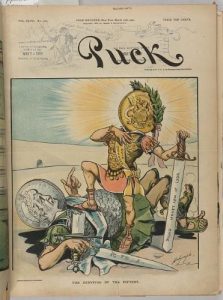Originally posted on Thursday, April 4th, 2013
BestThinking.com recently unearthed an excellent cover of Puck Magazine by Louis Dalrymple, illustrating the political tussle between the gold standard — formally enacted on March 14, 1900 — and the proponents of “free coinage of silver” as expounded by William Jennings Bryan.
 Image courtesy of Amazon.com
Image courtesy of Amazon.com
Pop culture still exalts Bryan’s 1896 rhetorical indictment of the gold standard, “you shall not press down upon the brow of labor this crown of thorns. You shall not crucify mankind upon a cross of gold” (recorded by Bryan later, and available for your listening pleasure here).
But history also records that Bryan, though unexcelled in rhetoric, was wrong about monetary policy. The vanquishing of cheap silver by valuable gold led to a golden age of opportunity — good and better jobs — for labor.
As economic historian, and advisor to thegoldstandardnow.org, Prof. Brian Domitrovic observed, in Forbes.com, of the later imposition of Bryan’s nostrums:
Dollars were showering the land, the cross of gold was history, and somehow farmers only got killed as never before. The doubling of the money supply increased the price level by a factor of two, halving the real income and assets of farmers, not to mention everyone else. Debt service was cheaper, but the things credit could buy cost twice as much. It is well-known even today in the Midwest that the 1920s were as desperate a decade as went the livelihoods of farmers as any, including the Great Depression years of the 1930s.
“Easy” money, rather than money with integrity as provided by the classical gold standard, proved the crown of thorns.
The true gold standard is much closer to a bed of roses for workers than is “easy money.”

Recent Comments